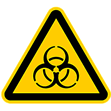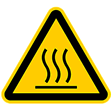Safety in the Laboratory

Safety in the Laboratory |
 |
Used to sterilize material or liquids (media) by humid heat. This is principally the recommended sterilization method - but not aplicable for heat-sensitive substances. Risk of contamination by biological material → escaping air during heating up → closing tap and draining system Risk of burns by hot vapor or spatter → Specially when opening the autoclave after autoclaving process Risk of explosion of autoclave when under pressure → obstaculization of safety valve → lack of maintenance of pressure equipment see "SI Autoclave" |
 
|
Always use special protective gloves against the heat. Use safety glases. Optical glasses are not allowed. |
  |
If the autoclave is big enough: - use the lower level for waste sterilization and upper level for clean material or media - place solid waste (e.g. Petri dishes) in plasic bags and liquids in a flask - do not fill more than 80% of the max. volumen! - never close bags or flasks tightly → vapor will not enter, thus no sterilization - sterilize small volumes (≤ 1 l) for 20 min @ 121 °C. Use more time for bigger volumes - use autoclaving tape to indicate if material has to be autoclaved or was walready autoclaved |
|
|
Principle: During heating up the autoclave vapor will be produced, which have to saturate the whole chamber → have sufficient water at the bottom of tha autoclave → at this moment not sterilized air will escape (risk of contamination!) When the chamber is vapor-saturated, the escape valve will close and overpressure will be build up → at 1 bar overpressure the temperature in the chamber(!) will be 121 °C → many autoclaves start to count the autoclaving time now → but 'in the chamber' does not mean 'in the good to autoclave' (e.g. media) → the bigger the medium flask the bigger the time difference between chamber and medium to reach 121 °C → for flasks ≥ 2 l the autoclaving time should be prolonged considerably → recommended (and in other countries obligatory) is a temperature probe in a reference flask that the autoclaving time starts counting when 121 °C are reached in the medium Afer autoclaving time finished, the autoclave starts to cool down → usually passive cooling (= stops heating) takes long time. Advantage: slow overpressure release, safe for liquid medium → at semi-active cooling the overpressure is released fastly. Disadvantage: liquid medium can boil over. No problem for solids (e.g. materials) → active cooling refers additionally to a cooling process by ventilation. Disadvantage: agar medium may solidify. No problem for solids (e.g. materials) → programmable autoclave can hold a temperature of 60 °C after autoclaving that agar does not solidify The autoclave should only be opened when the temperature (of the medium!) has reached 80 °C or less. → risk of burns by hot vapor at opening! → if the autoclaved goods are not needed immediately, keep the autoclave closed as long as possible. the chamber is sterile thus pressure compensation occures under sterile conditions! |
